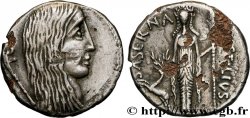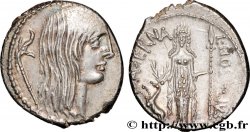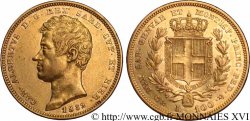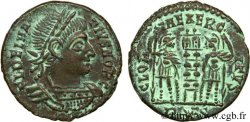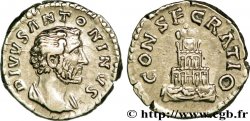v15_1493 - HOSTILIA Denier
MONNAIES 15 (2002)
Prezzo di inizio : 480.00 €
Valutazione : 1 000.00 €
Prezzo realizzato : 600.00 €
Numero di offerte : 5
Offerta maxima : 1 045.00 €
Prezzo di inizio : 480.00 €
Valutazione : 1 000.00 €
Prezzo realizzato : 600.00 €
Numero di offerte : 5
Offerta maxima : 1 045.00 €
Tipo : Denier
Data: 48 AC.
Nome della officina / città: Roma
Metallo : argento
Titolo in millesimi : + 950 ‰
Diametro : 17,5 mm
Asse di coniazione : 6 h.
Peso : 3,70 g.
Grado di rarità : R2
Commenti sullo stato di conservazione:
Beau portrait avec un minuscule petit coup sur la joue. A été légèrement nettoyé. Petite faiblesse de frappe au revers, sur un flan légèrement décentré sur une partie de la légende
N° nelle opere di riferimento :
B.2 (Hostilia) - BMC/RR.3994 - CRR.952 (3) - RRC.448 /2a - RSC.2 - RCV.418 (880$) - RHC.2 - CRI.18 (325£)
Diritto
Titolatura diritto : ANÉPIGRAPHE.
Descrittivo diritto : Tête barbue de guerrier gaulois à droite (Vercingétorix) ; derrière, un bouclier gaulois.
Rovescio
Titolatura rovescio : [L HOSTILIVS]/ SASERNA.
Descrittivo rovescio : Guerrier combattant dans un bige galopant à droite.
Traduzione rovescio : “Lucius Hostilius Saserna”, (Lucius Hostilius Saserna).
Commento
C’est le plus gaulois des deniers romains ou le plus romain des guerriers gaulois. La tête échevelée et barbue n’a rien à voir le buste élégant et hellénisant des statères arvernes épigraphes de Vercingetorix (LT. 3774-3778). Néanmoins, dans de nombreux ouvrages d’histoire ou de latin, c’est le visage du vaincu qui a été retenu, pour illustrer le chef gaulois, pour nous représenter l’image du chef battu par César qui devait être âgé et à demi-barbare afin de symboliser le combat de titan qui avait opposé les deux hommes dans la dernière phase de la Guerre des Gaules. N’oublions pas, au contraire, que le chef gaulois était âgé d’une vingtaine d’années quand il souleva la Gaule contre l’envahisseur et, n’en n’avait pas trente quand il fut étranglé dans sa prison à Rome. Encore une fois, c’est un acteur direct de la Guerre des Gaules, Lucius Hostilius Saserna, collaborateur de J. César, qui a fait frapper ce denier, deux ans avant le quadruple Triomphe de son ami et maître.
He is the most Gallic of Roman denarii or the most Roman of Gallic warriors. The disheveled and bearded head has nothing to do with the elegant and Hellenizing bust of the Arverni epigraph staters of Vercingetorix (LT. 3774-3778). Nevertheless, in many works of history or Latin, it is the face of the vanquished that has been chosen to illustrate the Gallic leader, to represent to us the image of the leader beaten by Caesar who must have been old and half-barbarian in order to symbolize the titanic combat that had opposed the two men in the last phase of the Gallic Wars. Let us not forget, on the contrary, that the Gallic leader was about twenty years old when he raised Gaul against the invader and was not yet thirty when he was strangled in his prison in Rome. Once again, it was a direct actor in the Gallic Wars, Lucius Hostilius Saserna, collaborator of J. Caesar, who had this denier struck, two years before the quadruple Triumph of his friend and master.
He is the most Gallic of Roman denarii or the most Roman of Gallic warriors. The disheveled and bearded head has nothing to do with the elegant and Hellenizing bust of the Arverni epigraph staters of Vercingetorix (LT. 3774-3778). Nevertheless, in many works of history or Latin, it is the face of the vanquished that has been chosen to illustrate the Gallic leader, to represent to us the image of the leader beaten by Caesar who must have been old and half-barbarian in order to symbolize the titanic combat that had opposed the two men in the last phase of the Gallic Wars. Let us not forget, on the contrary, that the Gallic leader was about twenty years old when he raised Gaul against the invader and was not yet thirty when he was strangled in his prison in Rome. Once again, it was a direct actor in the Gallic Wars, Lucius Hostilius Saserna, collaborator of J. Caesar, who had this denier struck, two years before the quadruple Triumph of his friend and master.








 Segnalare un errore
Segnalare un errore Stampate la pagina
Stampate la pagina Condividi mia selezione
Condividi mia selezione Fai una domanda
Fai una domanda Consegnare / vendere
Consegnare / vendere
 Descrittivo
Descrittivo